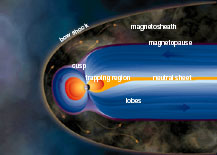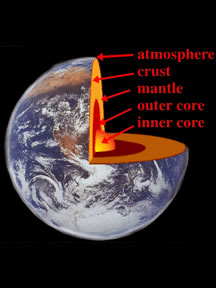This diagram shows the different layers found inside the Earth.
Click on image for full size
Windows Original.
Structure of the Interior of Earth
Earth has a diameter of approximately 12,756 km (7,972 mi). The Earth's interior consists of rock and metal. It is made up of four main layers:
1) the inner core: a solid metal core made up of nickel and iron (2440 km diameter)
2) the outer core: a liquid molten core of nickel and iron
3) the mantle: dense and mostly solid silicate rock
4) the crust: thin silicate rock material
The temperature increases rapidly up to 9000 F in the inner core. Therefore, the intense heat from the inner core causes material in the molten outer core and mantle to move around.
The movement of material deep within the Earth may cause large plates made of the crust and upper mantle, called the lithospheric plates, to move slowly over the Earth’s surface. It is also possible that these currents generate the Earth's magnetic field, called the magnetosphere.
Last modified January 18, 2010 by Lisa Gardiner.
You might also be interested in:

Many kinds of surface features provide evidence of a sliding lithosphere. When two plates move apart, rising material from the mantle pushes the lithosphere aside. Two types of features can form when
...more
The Earth has a magnetic field with north and south poles. The magnetic field of the Earth is enclosed in a region surrounding the Earth called the magnetosphere. As the Earth rotates, its hot core generates
...more
Earth’s center, or core, is very hot, about 9000 degrees F. This heat causes molten rock deep within the mantle layer to move. Warm material rises, cools, and eventually sinks down. As the cool material
...more
Earth has a magnetic field. If you imagine a gigantic bar magnet inside of Earth, you'll have a pretty good idea what Earth's magnetic field is shaped like. Of course, Earth DOESN'T have a giant bar magnet
...more
Earth's crust melts easier than previously thought, scientists have discovered. In a paper published in this week's issue of the journal Nature, geologists report results of a study of how well
...more
Mercury has a weak magnetic field. Like Earth's magnetic field, Mercury's dipole field is tilted with respect to the planet's spin axis. This means that Mercury's magnetic poles and its geographic poles
...more
Earth is the water planet. Big Idea 5.1 Water is found everywhere on Earth, from the heights of the atmosphere to the depths of the mantle. Early in Earth’s history, surface water accumulated through both
...more















